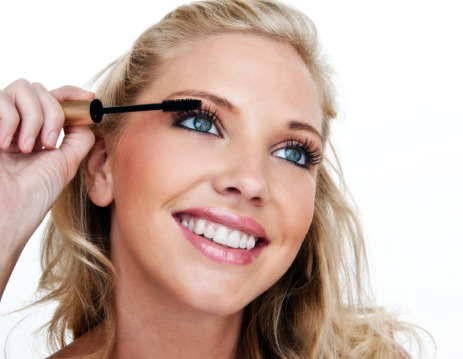Send your question to Umbra!
Q. Dear Umbra,
Lately, I’ve been learning about all the dangerous toxic chemicals in our cosmetics. One of which is sodium laureth sulphate, which is found in all the shampoos that I have. As there appears to be a hole in the system, exposing us to toxic chemicals on a daily basis, how can we find the safest and most natural cosmetics that really are natural and organic? Also are the same loopholes present with food and pharmaceutical products such as medicine?
Leena J.
London, UK
 Maybe she’s born with it, or maybe it’s propylene glycol.A. Dearest Leena,
Maybe she’s born with it, or maybe it’s propylene glycol.A. Dearest Leena,
You have seen beneath the pretty painted surface of cosmetics. It’s ugly under there, isn’t it?
The toxic truth is that fewer than 20 percent of chemicals in personal care products have been assessed for safety in the U.S. Laws that regulate this stuff haven’t been updated since 1938, creating more than loopholes, Leena. More like loopchasms! Across the pond where you live, standards are on the whole higher and don’t allow for some of the scary chemicals that wind up in products here in the U.S. You’re starting from a better product placement, so to speak.
For a primer on the problems of primpers, you can watch my video, “Wake up to your make up.”
Now, how do you find cosmetics that are less toxic, better for beauties, and the planet? I am not generally in the business of recommending specific products. I am but one person and the products in Consumerland are many!
I am in the business of providing resources, however, to help you think and shop critically. The key questions to ask when considering a personal care product are:
- What’s in it?
- Do I really need it? Can I get what this product provides in some other safe and healthy way?
First, do look for cosmetics whose ingredients are plant-based and organic. The word “natural” has no legal definition. So if you see it on packaging, make sure you also check the ingredients, naturally! Organic is only organic if it’s USDA certified organic. Look for the USDA green organic seal. (And even then it only has to be 70 percent organic, but that’s another story about organic standards.)
You’ll want to avoid the following (all too) common ingredients:
- Parabens are preservatives that act as endocrine disruptors and can lead to health problems. (Breast cancer tumors contain parabens in 19 out of 20 cases, according to an Environmental Working Group study.)
- Phthalates, used as solvents in many cosmetic products, can cause reproductive issues and make it harder to concentrate!
- Petrochemicals such as propylene glycol or mineral oil are no-nos. Really, who wants to put gasoline on their face?
- Sodium laureth sulfate is a skin irritant that acts as a gateway to known carcinogens found in everyday products like shampoo. It creates 1,4-dioxane, “a frequent contaminant of common cosmetics ingredients but as a contaminant it is not listed among intentionally added ingredients,” notes the Environmental Working Group.
- Anything with “fragrance,” a labeling loophole that allows perfume manufacturers to use a cadre of undisclosed, gnarly synthetic chemicals in their products.
Before you buy a product of the cosmetic variety, you might want to check its safety and environmental impact on the Environmental Working Group’s Skin Deep database. The database allows you to search a wide array of cosmetics, perfumes, deodorants, shampoo, and other personal products. Once you find out what’s in your potential cosmetic purchase you can decide whether you want those ingredients in or on your body.
If the answer is no, keep looking. Or make your own beauty products with better ingredients you choose yourself. There are companies out there that sell these healthy starters, and there are all kinds of recipes online — like this one for beet lip gloss, or my very own DIY shampoo and conditioner.
You also asked about the loopholes in the pharmaceutical and food industries, Leena. There’s one loophole of sorts where industrial agriculture and pharmaceuticals meet, and that’s with the use of antibiotics in Concentrated Animal Feed Operations. CAFOs, as they’re known, are basically factory farms that raise a lot of animals in a little space. CAFO livestock are dosed with antibiotics. As Tom Laskawy noted on Grist recently, “this practice — which by some estimates consumes nearly 70 percent of all antibiotics administered in the U.S. — has been linked to the rise of antibiotic resistance, both in common pathogens such as salmonella and in previously rare ones such as MRSA.”
There’s also been a lot of news lately about trace amounts of prescription drugs getting into our waterways. Some people are calling upon the U.S. Environmental Protection Agency to regulate this form of pharmaceutical pollution.
And finally, yes, there are holes in our food regulatory system. Check out my recent column on pink slime, a formerly inedible byproduct of the beef industry that is now found in 70 percent of hamburgers.
We’ve just scratched the surface here, Leena. But every little bit helps.
Freshfacedly,
Umbra
Get Off Your Ass Alert: If you’re concerned about lead in your lipstick or carcinogens in your first aid cream, send this article to all of your friends. Host a party where you watch Annie Leonard’s very enlightening and informative “Story of Cosmetics” followed by a discussion. And show your support for the Safe Cosmetics Act 2010!


